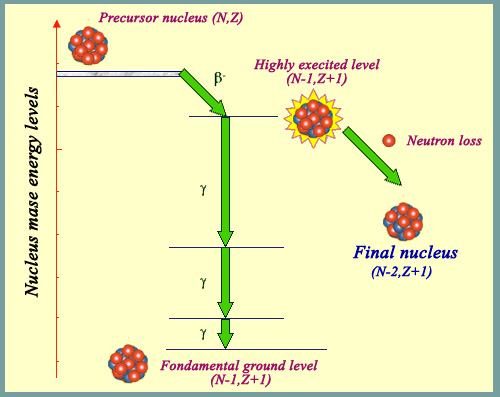A delay to control the chain reaction provided by Nature …
Between 2.5 to 3 primary neutrons are emitted on average during a fission. The newly formed fragments,, characterized by a large surplus in neutrons, undergo a series of beta decays with varying periods to reach stability. Sometimes one of the beta decay, leaves the nucleus in an highly excited state, whose excitation energy allows the nucleus to eject one neutron. Such a neutron is called a “delayed neutron” because it is issued well after the prompt neutrons of the fission itself. The fission products nuclei that emit these delayed neutrons are called precursors.

Production of a delayed neutron
Fission products, with a surplus of neutrons, undergo a series of beta decays to correct this excess and regain stability. One of these decays, may leave the nucleus in an highly excited state. It generally reacts by issuing desexcitation gamma photons. However if the excitation energy is sufficient, it has the alternative to eject a neutron. Because of the half-lives of the precursor and its ancestors, the neutron is expelled after a delay that can reach a few minutes.
© IN2P3
The delay between the fission with the emission of prompt neutrons and the emission of delayed neutrons, may vary from hundredth of a second to tens of seconds according to the precursor nuclei. Delayed neutrons are few compared to prompt neutrons. In the case of PWR reactors, they amount to 0,7 % of all neutrons produced.
Despite their small proportion, delayed neutrons are a key feature of the conduct of reactors and their safety. Their existence, the delay, gives time to correct positive variations of the chain reaction criticity that should remain equal to one. They are a useful tool, offered by Nature, to operate and control reactors.